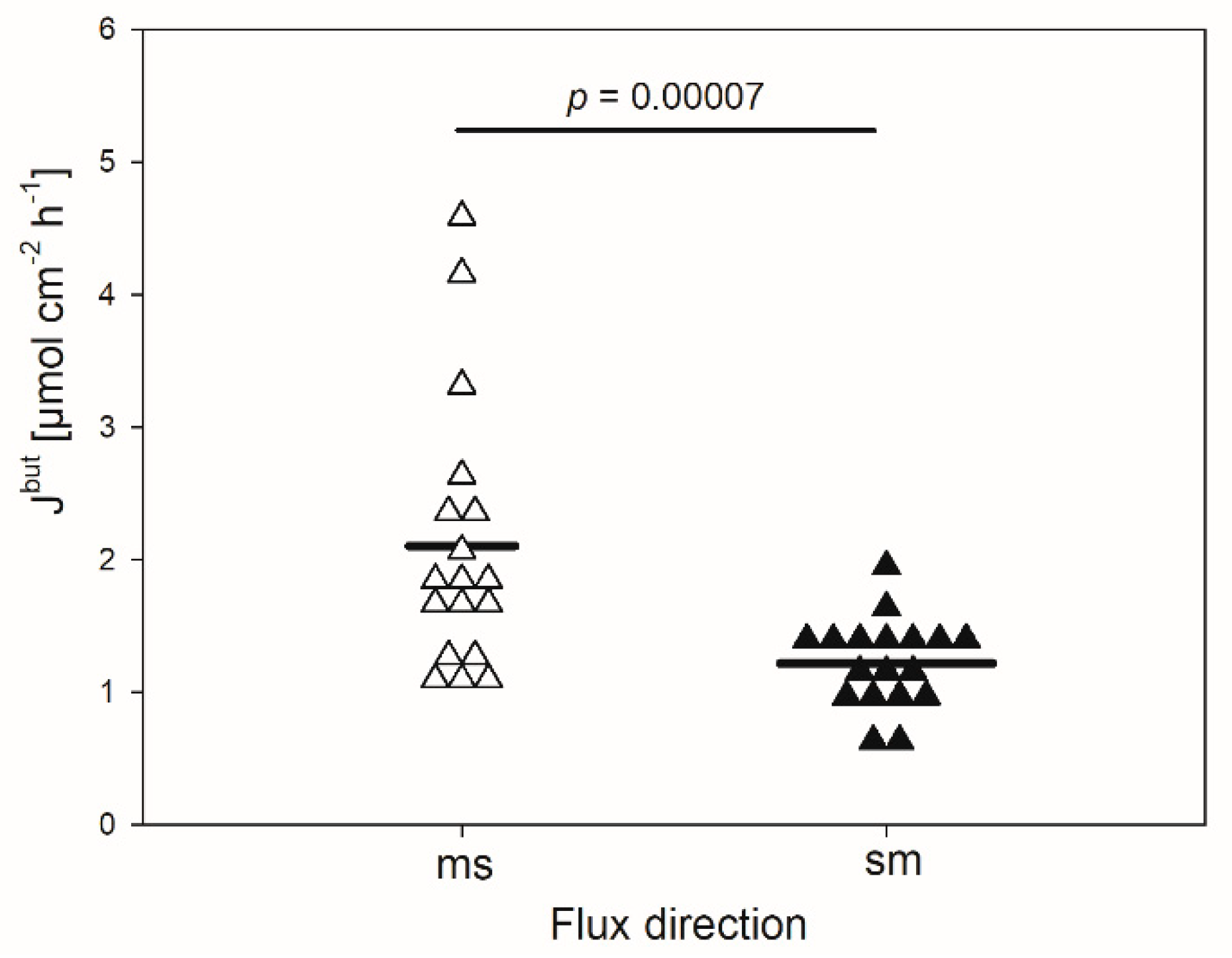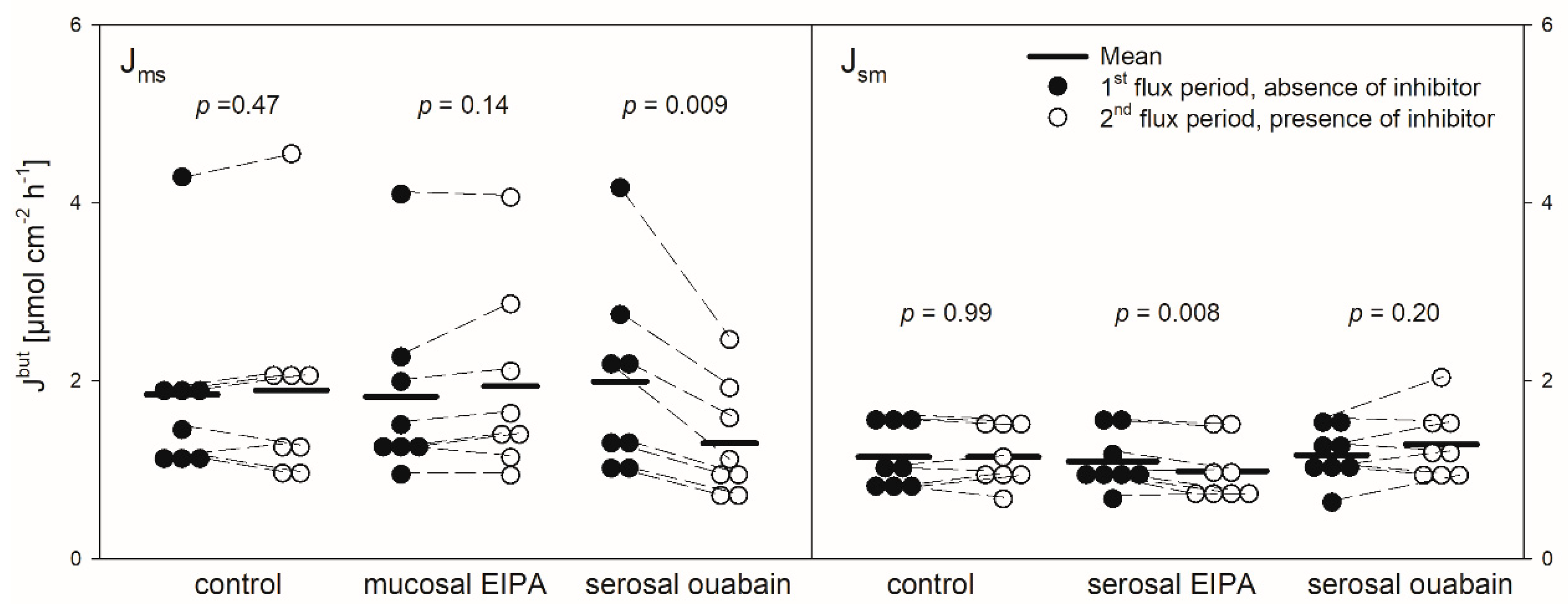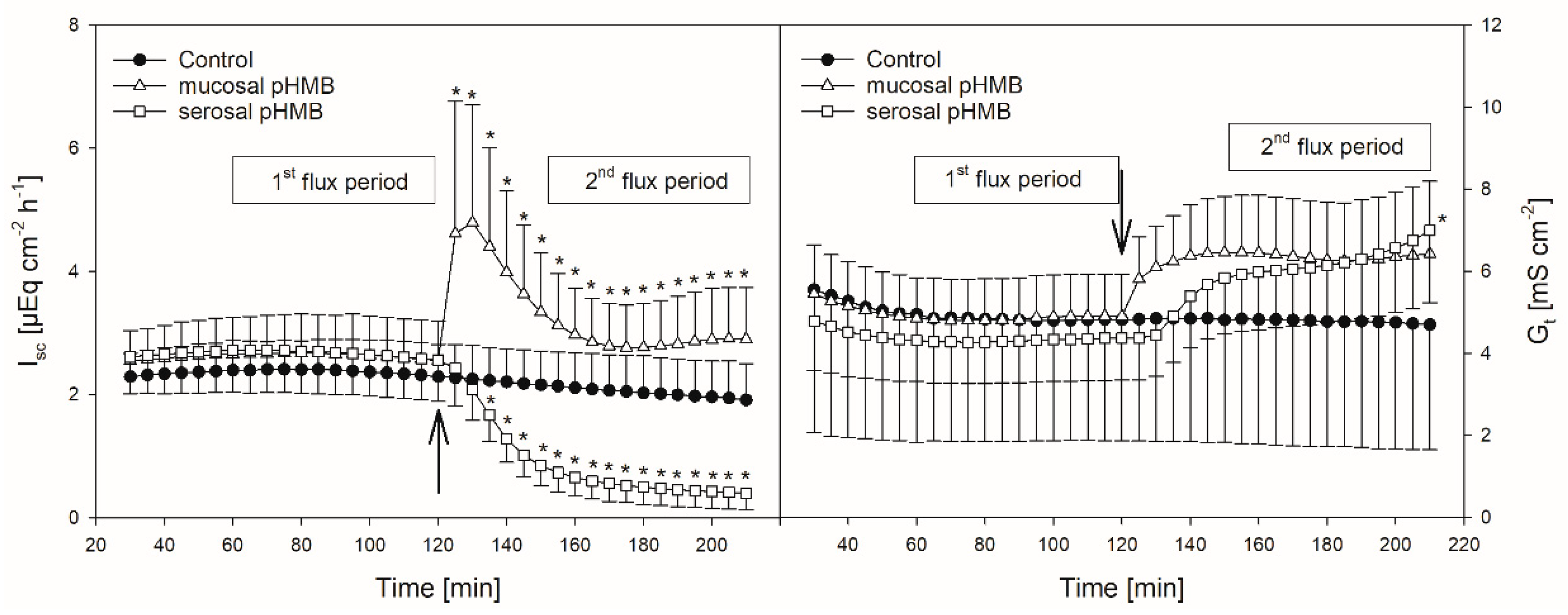Butyrate Permeation across the Isolated Ovine Reticulum Epithelium
Abstract
:Simple Summary
Abstract
1. Introduction
2. Materials and Methods
2.1. Chemicals and Buffer Solutions
2.2. Animals and Ethical Approval
2.3. Incubation
2.4. Electrophysiology
2.5. Butyrate Flux Rates
2.6. Statistics
3. Results
3.1. Control Conditions
3.2. pHMB
3.3. EIPA
3.4. Ouabain
4. Discussion
5. Conclusions
Author Contributions
Funding
Acknowledgments
Conflicts of Interest
References
- Achilles, W. Anatomie Für Die Tiermedizin, 2., Überarb. und erw. Aufl; Enke: Stuttgart, Germany, 2008; ISBN 3-8304-1007-7. [Google Scholar]
- Baaske, L.; Gäbel, G.; Dengler, F. Ruminal epithelium: A checkpoint for cattle health. J. Dairy Res. 2020, 1–8. [Google Scholar] [CrossRef]
- Bergman, E.N. Energy contributions of volatile fatty acids from the gastrointestinal tract in various species. Physiol. Rev. 1990, 70, 567–590. [Google Scholar] [CrossRef] [PubMed] [Green Version]
- Gäbel, G.; Aschenbach, J.R.; Müller, F. Transfer of energy substrates across the ruminal epithelium: Implications and limitations. Anim. Health Res. Rev. 2002, 3, 15–30. [Google Scholar] [CrossRef]
- López, S.; Hovell, F.D.D.; Dijkstra, J.; France, J. Effects of volatile fatty acid supply on their absorption and on water kinetics in the rumen of sheep sustained by intragastric infusions. J. Anim. Sci. 2003, 81, 2609–2616. [Google Scholar] [CrossRef] [PubMed]
- Rémond, D.; Ortigues, I.; Jouany, J.P. Energy substrates for the rumen epithelium. Proc. Nutr. Soc. 1995, 54, 95–105. [Google Scholar] [CrossRef] [PubMed] [Green Version]
- Sehested, J.; Diernaes, L.; Møller, P.D.; Skadhauge, E. Transport of butyrate across the isolated bovine rumen epithelium--interaction with sodium, chloride and bicarbonate. Comp. Biochem. Physiol. Part A Mol. Integr. Physiol. 1999, 123, 399–408. [Google Scholar] [CrossRef]
- Bilk, S.; Huhn, K.; Honscha, K.U.; Pfannkuche, H.; Gäbel, G. Bicarbonate exporting transporters in the ovine ruminal epithelium. J. Comp. Physiol. B Biochem. Syst. Environ. Physiol. 2005, 175, 365–374. [Google Scholar] [CrossRef]
- Aschenbach, J.R.; Bilk, S.; Tadesse, G.; Stumpff, F.; Gäbel, G. Bicarbonate-dependent and bicarbonate-independent mechanisms contribute to nondiffusive uptake of acetate in the ruminal epithelium of sheep. Am. J. Physiol. Gastrointest. Liver Physiol. 2009, 296, G1098–G1107. [Google Scholar] [CrossRef]
- Müller, F.; Huber, K.; Pfannkuche, H.; Aschenbach, J.R.; Breves, G.; Gäbel, G. Transport of ketone bodies and lactate in the sheep ruminal epithelium by monocarboxylate transporter 1. Am. J. Physiol. Gastrointest. Liver Physiol. 2002, 283, G1139–G1146. [Google Scholar] [CrossRef] [Green Version]
- Kirat, D.; Masuoka, J.; Hayashi, H.; Iwano, H.; Yokota, H.; Taniyama, H.; Kato, S. Monocarboxylate transporter 1 (MCT1) plays a direct role in short-chain fatty acids absorption in caprine rumen. J. Physiol. 2006, 576, 635–647. [Google Scholar] [CrossRef]
- Dengler, F.; Rackwitz, R.; Benesch, F.; Pfannkuche, H.; Gäbel, G. Bicarbonate-dependent transport of acetate and butyrate across the basolateral membrane of sheep rumen epithelium. Acta Physiol. 2014, 210, 403–414. [Google Scholar] [CrossRef] [PubMed]
- Stumpff, F.; Martens, H.; Bilk, S.; Aschenbach, J.R.; Gäbel, G. Cultured ruminal epithelial cells express a large-conductance channel permeable to chloride, bicarbonate, and acetate. Pflugers Arch. 2009, 457, 1003–1022. [Google Scholar] [CrossRef] [PubMed] [Green Version]
- Rackwitz, R.; Gäbel, G. Permeation of acetate across sheep ruminal epithelium is partly mediated by an anion channel. Res. Vet. Sci. 2017, 117, 10–17. [Google Scholar] [CrossRef] [PubMed]
- Rabbani, I.; Siegling-Vlitakis, C.; Noci, B.; Martens, H. Evidence for NHE3-mediated Na transport in sheep and bovine forestomach. Am. J. Physiol. Regul. Integr. Comp. Physiol. 2011, 301, R313–R319. [Google Scholar] [CrossRef] [Green Version]
- Huhn, K.; Müller, F.; Honscha, K.U.; Pfannkuche, H.; Gäbel, G. Molecular and functional evidence for a Na(+)-HCO3(-)-cotransporter in sheep ruminal epithelium. J. Comp. Physiol. B Biochem. Syst. Environ. Physiol. 2003, 173, 277–284. [Google Scholar] [CrossRef]
- Schnorr, B. Histochemische, elektronenmikroskopischeund biochemische Untersuchungen uber die ATPasen im Vormagenepithel der Ziege. Z. Zellforsch. Mikrosk. Anat. 1971, 114, 365–389. [Google Scholar] [CrossRef]
- Gäbel, G.; Vogler, S.; Martens, H. Mechanisms of sodium and chloride transport across isolated sheep reticulum. Comp. Biochem. Physiol. Comp. Physiol. 1993, 105, 1–10. [Google Scholar] [CrossRef]
- Mensching, A.; Bünemann, K.; Meyer, U.; von Soosten, D.; Hummel, J.; Schmitt, A.O.; Sharifi, A.R.; Dänicke, S. Modeling reticular and ventral ruminal pH of lactating dairy cows using ingestion and rumination behavior. J. Dairy Sci. 2020. [Google Scholar] [CrossRef]
- Sato, S. Pathophysiological evaluation of subacute ruminal acidosis (SARA) by continuous ruminal pH monitoring. Anim. Sci. J. 2016, 87, 168–177. [Google Scholar] [CrossRef] [Green Version]
- Falk, M.; Munger, A.; Dohme-Meier, F. Technical note: A comparison of reticular and ruminal pH monitored continuously with 2 measurement systems at different weeks of early lactation. J. Dairy Sci. 2016, 99, 1951–1955. [Google Scholar] [CrossRef]
- Leonhard-Marek, S.; Gäbel, G.; Martens, H. Effects of short chain fatty acids and carbon dioxide on magnesium transport across sheep rumen epithelium. Exp. Physiol. 1998, 83, 155–164. [Google Scholar] [CrossRef] [PubMed] [Green Version]
- Penner, G.B.; Aschenbach, J.R.; Gäbel, G.; Rackwitz, R.; Oba, M. Epithelial capacity for apical uptake of short chain fatty acids is a key determinant for intraruminal pH and the susceptibility to subacute ruminal acidosis in sheep. J. Nutr. 2009, 139, 1714–1720. [Google Scholar] [CrossRef] [PubMed] [Green Version]
- Penner, G.B.; Steele, M.A.; Aschenbach, J.R.; McBride, B.W. Ruminant nutrition symposium: Molecular adaptation of ruminal epithelia to highly fermentable diets. J. Anim. Sci. 2011, 89, 1108–1119. [Google Scholar] [CrossRef] [PubMed] [Green Version]
- Kristensen, N.B.; Harmon, D.L. Splanchnic metabolism of volatile fatty acids absorbed from the washed reticulorumen of steers. J. Anim. Sci. 2004, 82, 2033–2042. [Google Scholar] [CrossRef] [PubMed]
- Wiese, B.I.; Górka, P.; Mutsvangwa, T.; Okine, E.; Penner, G.B. Short communication: Interrelationship between butyrate and glucose supply on butyrate and glucose oxidation by ruminal epithelial preparations. J. Dairy Sci. 2013, 96, 5914–5918. [Google Scholar] [CrossRef] [Green Version]
- Gäbel, G.; Müller, F.; Pfannkuche, H.; Aschenbach, J.R. Influence of isoform and DNP on butyrate transport across the sheep ruminal epithelium. J. Comp. Physiol. B Biochem. Syst. Environ. Physiol. 2001, 171, 215–221. [Google Scholar] [CrossRef]
- Diernaes, L.; Sehested, J.; Møller, P.D.; Skadhauge, E. Sodium and chloride transport across the rumen epithelium of cattle in vitro: Effect of short-chain fatty acids and amiloride. Exp. Physiol. 1994, 79, 755–762. [Google Scholar] [CrossRef] [Green Version]
- Krehbiel, C.R.; Harmon, D.L.; Schneider, J.E. Effect of increasing ruminal butyrate on portal and hepatic nutrient flux in steers. J. Anim. Sci. 1992, 70, 904–914. [Google Scholar] [CrossRef] [Green Version]
- Kristensen, N.B.; Pierzynowski, S.G.; Danfaer, A. Net portal appearance of volatile fatty acids in sheep intraruminally infused with mixtures of acetate, propionate, isobutyrate, butyrate, and valerate. J. Anim. Sci. 2000, 78, 1372–1379. [Google Scholar] [CrossRef] [Green Version]
- Stumpff, F. A look at the smelly side of physiology: Transport of short chain fatty acids. Pflugers Arch. 2018, 470, 571–598. [Google Scholar] [CrossRef]
- Cistola, D.P.; Small, D.M.; Hamilton, J.A. Ionization behavior of aqueous short-chain carboxylic acids: A carbon-13 NMR study. J. Lipid Res. 1982, 23, 795–799. [Google Scholar] [PubMed]
- Müller, F.; Aschenbach, J.R.; Gäbel, G. Role of Na+/H+ exchange and HCO3− transport in pHi recovery from intracellular acid load in cultured epithelial cells of sheep rumen. J. Comp. Physiol. B Biochem. Syst. Environ. Physiol. 2000, 170, 337–343. [Google Scholar]
- Graham, C.; Gatherar, I.; Haslam, I.; Glanville, M.; Simmons, N.L. Expression and localization of monocarboxylate transporters and sodium/proton exchangers in bovine rumen epithelium. Am. J. Physiol. Regul. Integr. Comp. Physiol. 2007, 292, R997–R1007. [Google Scholar] [CrossRef] [PubMed] [Green Version]
- Kramer, T.; Michelberger, T.; Gürtler, H.; Gäbel, G. Absorption of short-chain fatty acids across ruminal epithelium of sheep. J. Comp. Physiol. B Biochem. Syst. Environ. Physiol. 1996, 166, 262–269. [Google Scholar] [CrossRef] [PubMed]
- Martens, H.; Gäbel, G.; Strozyk, B. Mechanism of electrically silent Na and Cl transport across the rumen epithelium of sheep. Exp. Physiol. 1991, 76, 103–114. [Google Scholar] [CrossRef] [Green Version]
- Gäbel, G.; Vogler, S.; Martens, H. Short-chain fatty acids and CO2 as regulators of Na+ and Cl− absorption in isolated sheep rumen mucosa. J. Comp. Physiol. B Biochem. Syst. Environ. Physiol. 1991, 161, 419–426. [Google Scholar] [CrossRef]
- Gäbel, G.; Smith, E.; Rothenpieler, P.; Martens, H. Interrelations between short-chain fatty acids and sodium absorption in the rumen of sheep. Acta Vet. Scand. Suppl. 1989, 86, 134–136. [Google Scholar]
- Sehested, J.; Diernaes, L.; Moller, P.D.; Skadhauge, E. Transport of sodium across the isolated bovine rumen epithelium: Interaction with short-chain fatty acids, chloride and bicarbonate. Exp. Physiol. 1996, 81, 79–94. [Google Scholar] [CrossRef] [Green Version]
- Bilk, S. Mechanismen der Anionischen SCFA-Resorption im Pansen des Schafes. Ph.D. Thesis, Universität Leipzig, Leipzig, Germany, 2007. [Google Scholar]
- Baldwin, R.L.; Wu, S.; Li, W.; Li, C.; Bequette, B.J.; Li, R.W. Quantification of Transcriptome Responses of the Rumen Epithelium to Butyrate Infusion using RNA-seq Technology. Gene Regul. Syst. Biol. 2012, 6, 67–80. [Google Scholar] [CrossRef] [Green Version]
- Hansen, O. Isoform of Na+, K+-ATPase from rumen epithelium identified and quantified by immunochemical methods. Acta Physiol. Scand. 1998, 163, 201–208. [Google Scholar] [CrossRef]
- Kristensen, N.B.; Hansen, O.; Clausen, T. Measurement of the total concentration of functional Na+, K+-pumps in rumen epithelium. Acta Physiol. Scand. 1995, 155, 67–76. [Google Scholar] [CrossRef] [PubMed]
- Harrison, F.A.; Keynes, R.D.; Rankin, J.C.; Zurich, L. The effect of ouabain on ion transport across isolated sheep rumen epithelium. J. Physiol. 1975, 249, 669–677. [Google Scholar] [CrossRef] [Green Version]
- Kirat, D.; Matsuda, Y.; Yamashiki, N.; Hayashi, H.; Kato, S. Expression, cellular localization, and functional role of monocarboxylate transporter 4 (MCT4) in the gastrointestinal tract of ruminants. Gene 2007, 391, 140–149. [Google Scholar] [CrossRef]
- Pfannkuche, H.; Taifour, F.; Steinhoff-Wagner, J.; Hammon, H.M.; Gäbel, G. Post-natal changes in MCT1 expression in the forestomach of calves. J. Anim. Physiol. Anim. Nutr. 2014, 98, 140–148. [Google Scholar] [CrossRef] [PubMed]
- Alameen, A.O.A.; Rackwitz, R. Anion exchanger proteins: Participation in extrusion of SCFA and their metabolites across basolateral membrane of ruminal epithelia. In Proceedings of the Society of Nutrition Physiology, Göttingen, Germany, 18 March 2014; p. 79. [Google Scholar]
- Kekuda, R.; Manoharan, P.; Baseler, W.; Sundaram, U. Monocarboxylate 4 mediated butyrate transport in a rat intestinal epithelial cell line. Dig. Dis. Sci. 2013, 58, 660–667. [Google Scholar] [CrossRef]
- Santos, K.L.; Vento, M.A.; Wright, J.W.; Speth, R.C. The effects of para-chloromercuribenzoic acid and different oxidative and sulfhydryl agents on a novel, non-AT1, non-AT2 angiotensin binding site identified as neurolysin. Regul. Pept. 2013, 184, 104–114. [Google Scholar] [CrossRef] [PubMed] [Green Version]
- Rosendahl, J.; Braun, H.S.; Schrapers, K.T.; Martens, H.; Stumpff, F. Evidence for the functional involvement of members of the TRP channel family in the uptake of Na+ and NH4+ by the ruminal epithelium. Pflugers Arch. 2016, 468, 1333–1352. [Google Scholar] [CrossRef]
- Lin, S.; Ayala, G.F. Effect of sulfhydryl group agents on the crayfish stretch receptor neuron. Comp. Biochem. Physiol. 1983, 75, 231–237. [Google Scholar]
- Li, Z.; Neufeld, G.J. Isolation and characterization of mitochondrial F1-ATPase from crayfish (Orconectes virilis) gills. Comp. Biochem. Physiol. Part B Biochem. Mol. Biol. 2001, 128, 325–338. [Google Scholar] [CrossRef]
- Georgi, M.I.; Rosendahl, J.; Ernst, F.; Günzel, D.; Aschenbach, J.R.; Martens, H.; Stumpff, F. Epithelia of the ovine and bovine forestomach express basolateral maxi-anion channels permeable to the anions of short-chain fatty acids. Pflugers Arch. Eur. J. Physiol. 2014, 466, 1689–1712. [Google Scholar] [CrossRef]
- Omer, A.O.A. Involvement of the Putative Anion Transporter 1 (SLC26A6) in Permeation of Short Chain Fatty Acids and Their Metabolites across the Basolateral Membrane of Ovine Ruminal Epithelium. Ph.D. Thesis, Universität Leipzig, Leipzig, Germany, 2016. [Google Scholar]





| Metric | Control | Mucosal pHMB | Serosal pHMB |
|---|---|---|---|
| Isc mean, 1st flux period | 2.37 ± 0.49 | 2.64 ± 0.62 p = 0.118 | 2.67 ± 0.68 p = 0.106 |
| Isc mean, 2nd flux period | 2.04 ± 0.58 | 2.9 ± 0.76 * p = 0.007 | 0.54 ± 0.28 * p = 0.003 |
| Δ Isc mean | −0.34 ± 0.17 | 0.26 ± 0.38 * p = 0.005 | −2.13 ± 0.59 * p = 0.001 |
| Max Isc | 2.49 ± 0.49 | 5.04 ± 2.05 * p = 0.012 | 2.75 ± 0.68 p = 0.13 |
| Min Isc | 1.82 ± 0.45 | 2.44 ± 0.55 * p = 0.006 | 0.39 ± 0.27 * p = 0.001 |
| Gt mean, 1st flux period | 4.83 ± 2.97 | 4.85 ± 1.83 p = 0.988 | 4.31 ± 1.01 p = 0.652 |
| Gt mean, 2nd flux period | 4.78 ± 3.05 | 6.34 ± 2.51 p = 0.363 | 6.22 ± 1.46 p = 0.21 |
| Δ Gt mean | −0.04 ± 0.16 | 1.51 ± 0.73 * p = 0.004 | 1.91 ± 0.72 * p = 0.000 |
| Max Gt | 5.64 ± 3.62 | 6.58 ± 2.66 p = 0.623 | 7.00 ± 1.76 p = 0.322 |
| Min Gt | 4.56 ± 2.85 | 4.76 ± 1.82 p = 0.891 | 4.2 ± 0.99 p = 0.752 |
Publisher’s Note: MDPI stays neutral with regard to jurisdictional claims in published maps and institutional affiliations. |
© 2020 by the authors. Licensee MDPI, Basel, Switzerland. This article is an open access article distributed under the terms and conditions of the Creative Commons Attribution (CC BY) license (http://creativecommons.org/licenses/by/4.0/).
Share and Cite
Rackwitz, R.; Dengler, F.; Gäbel, G. Butyrate Permeation across the Isolated Ovine Reticulum Epithelium. Animals 2020, 10, 2198. https://doi.org/10.3390/ani10122198
Rackwitz R, Dengler F, Gäbel G. Butyrate Permeation across the Isolated Ovine Reticulum Epithelium. Animals. 2020; 10(12):2198. https://doi.org/10.3390/ani10122198
Chicago/Turabian StyleRackwitz, Reiko, Franziska Dengler, and Gotthold Gäbel. 2020. "Butyrate Permeation across the Isolated Ovine Reticulum Epithelium" Animals 10, no. 12: 2198. https://doi.org/10.3390/ani10122198
APA StyleRackwitz, R., Dengler, F., & Gäbel, G. (2020). Butyrate Permeation across the Isolated Ovine Reticulum Epithelium. Animals, 10(12), 2198. https://doi.org/10.3390/ani10122198






